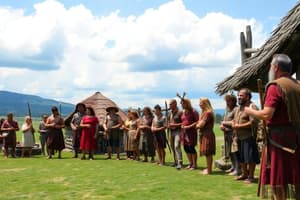Podcast
Questions and Answers
What is a key characteristic of tribal societies?
What is a key characteristic of tribal societies?
- Reliance on modern amenities
- Large population size
- Autonomous self-governance (correct)
- Fragmented language and culture
What is the typical population size range of tribal societies?
What is the typical population size range of tribal societies?
- Few dozen to few hundred people
- Few thousand to few million people
- Few hundred to few thousand people (correct)
- Few million to billion people
Which factor contributes to the strong sense of community and identity in tribal societies?
Which factor contributes to the strong sense of community and identity in tribal societies?
- Diversity of language and culture
- Common language and culture (correct)
- Rapid population growth
- Isolation from modern amenities
Where are tribal societies often located?
Where are tribal societies often located?
What type of economies do tribal societies typically have?
What type of economies do tribal societies typically have?
What is the basis of social organization in tribal societies?
What is the basis of social organization in tribal societies?
In addition to agriculture, what other activity do many tribal societies engage in for livelihood?
In addition to agriculture, what other activity do many tribal societies engage in for livelihood?
What are some key aspects of economic systems in tribal societies?
What are some key aspects of economic systems in tribal societies?
What is a significant challenge faced by tribal societies due to rapid development in the modern world?
What is a significant challenge faced by tribal societies due to rapid development in the modern world?
What can have a significant impact on tribal societies, affecting their agricultural practices and livelihoods?
What can have a significant impact on tribal societies, affecting their agricultural practices and livelihoods?
What is a source of income for some tribal societies, received from members who have migrated to urban areas or other countries?
What is a source of income for some tribal societies, received from members who have migrated to urban areas or other countries?
What is an important activity undertaken by tribal societies in addition to agriculture?
What is an important activity undertaken by tribal societies in addition to agriculture?
What can limit the development opportunities for many tribal societies?
What can limit the development opportunities for many tribal societies?
What can have a significant impact on tribal societies' agricultural practices and livelihoods?
What can have a significant impact on tribal societies' agricultural practices and livelihoods?
Study Notes
Introduction
Tribal society refers to a social organization characterized by a small, autonomous group of people who share a common language, culture, and kinship ties. These societies are often found in rural or remote areas, and their members typically have a close-knit relationship with one another, relying on each other for support and sustenance. In this article, we will explore the characteristics of tribal society, their economic systems, and the challenges they face in the modern world.
Characteristics of Tribal Society
-
Small-scale: Tribal societies are typically small, with a population ranging from a few hundred to a few thousand people.
-
Autonomous: Tribal societies are often self-governing, with their members making decisions collectively and without external interference.
-
Common language and culture: Members of tribal societies share a common language and culture, which helps to foster a strong sense of community and identity.
-
Kinship ties: Tribal societies are often based on kinship ties, with members being related by blood or marriage.
-
Rural or remote: Tribal societies are often located in rural or remote areas, which can make access to modern amenities and services difficult.
Economic Systems
Tribal societies typically have mixed economies, combining elements of both subsistence and market economies. Some key aspects of their economic systems include:
-
Agriculture: Many tribal societies rely on agriculture for their livelihoods, growing crops such as rice, wheat, and corn.
-
Animal husbandry: In addition to agriculture, many tribal societies also raise animals for food and other products.
-
Crafts and trade: Tribal societies often engage in crafts and trade, producing and exchanging goods and services with one another and with neighboring communities.
-
Remittances: Some tribal societies receive remittances from members who have migrated to urban areas or other countries, providing an important source of income.
Challenges in the Modern World
Tribal societies face numerous challenges in the modern world, including:
-
Access to resources: Many tribal societies struggle to access resources such as healthcare, education, and infrastructure, which can limit their development opportunities.
-
Climate change: Climate change can have a significant impact on tribal societies, affecting their agricultural practices and livelihoods.
-
Development: Rapid development in the modern world can threaten the traditional way of life of tribal societies, as their lands are often targeted for resource extraction and other forms of commercial development.
-
Displacement: Tribal societies are often displaced from their lands due to conflict, development, or other factors, which can lead to significant hardships and loss of culture.
Conclusion
Tribal societies are unique and complex communities, characterized by their small size, autonomous governance, and strong sense of community. Their economic systems are typically mixed, combining elements of subsistence and market economies. Despite their resilience, tribal societies face numerous challenges in the modern world, including limited access to resources, climate change, development threats, and displacement. It is essential to understand and support these communities in order to preserve their cultures and ensure their long-term survival.
Studying That Suits You
Use AI to generate personalized quizzes and flashcards to suit your learning preferences.
Description
Explore the unique characteristics and economic systems of tribal societies, as well as the challenges they face in the modern world. Learn about their small-scale, autonomous nature, reliance on agriculture and animal husbandry, and the threats posed by climate change and rapid development.




